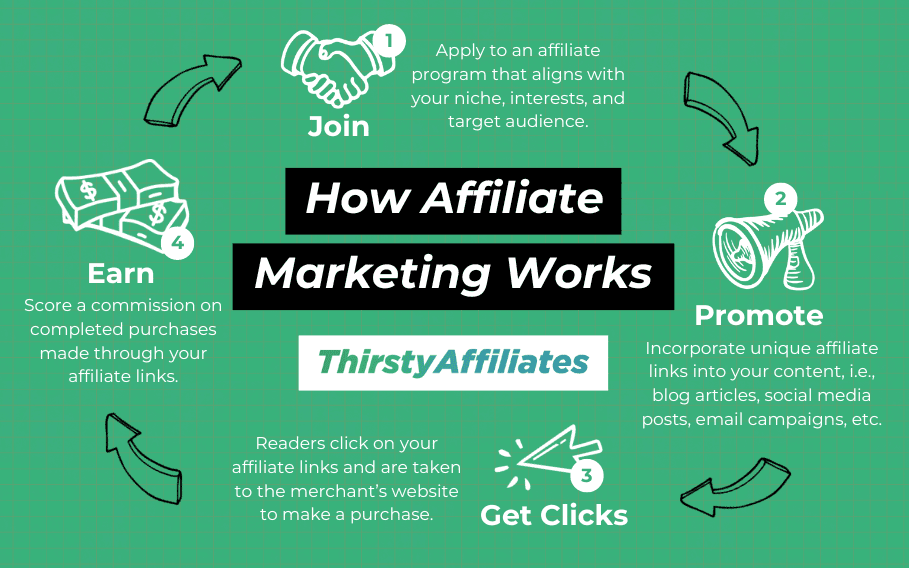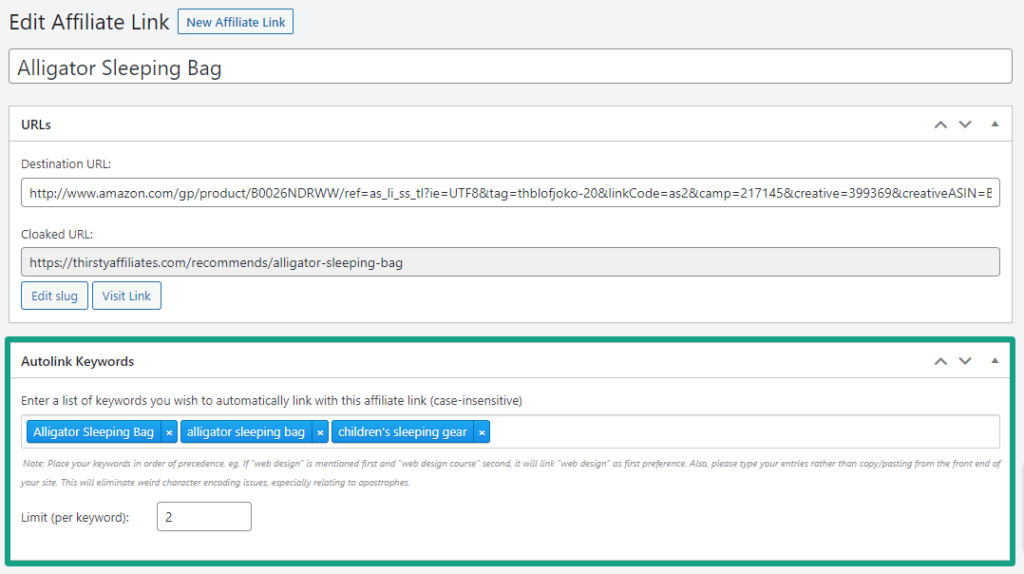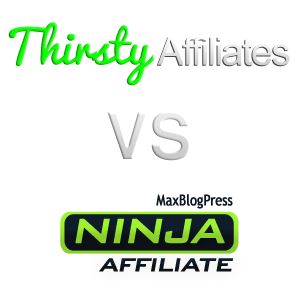Contents

Ready to crack the code on affiliate marketing? Well, you’ve come to the right place! This post is all about demystifying all the marketing jargon you keep hearing in the affiliate marketing world.
Whether you’re a newbie trying to make sense of it all or just brushing up on the basics, understanding the terminology behind it all is key. Knowing things like “Affiliate Networks” and “Conversion Rates” isn't just about keeping up with the competition – it’s about making these concepts work for you.
Each concept you grasp can significantly impact your strategy and earnings.
We're going to walk through this glossary together, breaking down what each term means and how you can use them to your advantage. This way, you’ll not only get to grips with the lingo but also start to see how each term plays a role in your marketing tactics.
Affiliate Marketing Terms You Need to Know
A
Affiliate
An affiliate, sometimes called a publisher or associate, is someone who promotes products or services on behalf of a company, typically through blogs, social media, or websites. Affiliates earn commissions or other forms of compensation for creating connections between businesses and potential customers, effectively serving as a bridge to new sales.
Affiliate Link
An affiliate link contains a unique tracking code provided by a company or merchant. This link enables the ability to monitor sales or leads generated by the affiliate, ensuring every conversion is attributed correctly and that the affiliate is compensated for their efforts.
Affiliate Marketing
Affiliate marketing is a performance-based system where affiliates earn commissions for generating sales through their unique affiliate links. These links, embedded with special tracking codes, allow companies to trace sales back to the affiliate's promotional efforts, rewarding them for each successful referral.

Affiliate Program
An affiliate program is a formal partnership set up by businesses that offers affiliates the opportunity to earn commissions by promoting their products or services. This arrangement benefits both the business, which gains new customers, and affialites, who earns for endorsements.
Affiliate Network
An affiliate network acts as a central hub, much like a marketplace, where affiliates and companies meet. Here, affiliates can find products that align with their audience's interests, ensuring a good match between the promoted items and the needs or desires of their followers.
B
Backlinks
Backlinks are links from other websites that lead back to yours, functioning like digital endorsements. These are the internet's way of validating your content's quality. A high-quality backlink from a reputable site can significantly boost your website's credibility and enhance its ranking in search engine results.
It's as if each backlink says, “This site has good stuff,” helping to boost your visibility in the vast online landscape.
Banner Ad
A banner ad is a digital advertisement displayed on your website or blog. It's designed to catch the eye with vibrant graphics and entice visitors to learn more about an advertiser’s product or service.
When you place these ads strategically, you help promote these offerings and every click on a banner ad not only brings a potential customer one step closer to a purchase but also brings you closer to earning a commission.
Black Hat SEO
Black Hat SEO refers to the use of unethical techniques aimed at manipulating search engine rankings. While these methods may offer a quick rise in rankings, they carry significant risks.
Dearch engines, acting as strict enforcers, can penalize or even blacklist sites using these deceptive practices, leading to a loss in traffic and credibility.
Blog
A blog is your personal space on the internet, where you can express thoughts, share experiences, or offer expertise. It's like having your own digital corner where you can connect with a global audience through original content, ranging from insightful analyses to entertaining stories, all tailored to engage and inform your readers.
C
Cloaking
Cloaking transforms the typically long and cumbersome affiliate URLs into cleaner, more user-friendly versions. This process not only makes the links more appealing but also shields them from hijacking, ensuring the integrity of your affiliate tracking.

By cloaking your links, you protect your commissions and ensure that all referrals are accurately credited to you.
Commission
A commission is essentially a reward from advertisers to affiliates for successful promotions. It's the fee you earn each time your efforts lead a customer to make a purchase. The better you are at connecting potential buyers with the right products or services, the more you can increase your earnings through commissions.
Consumer Journey
The consumer journey traces a customer's path from initial awareness of a product to the final decision to purchase. This term encompasses the entire experience a consumer goes through, highlighting key decision points and interactions along the way.
Content Marketing
Content marketing uses storytelling and valuable information to attract and engage an audience. Rather than directly selling, this strategy involves creating content – like articles, videos, and podcasts – that educates, entertains, or informs, building trust and authority over time.
This approach subtly nudges your audience toward making informed purchase decisions.
Contextual Link
A contextual link is a hyperlink embedded within text that is relevant to the content around it. These links provide additional information or resources, enhancing the value and user experience of your content by offering more depth on discussed topics.
Conversion
A conversion occurs when a visitor to your website or landing page takes a desired action, such as making a purchase, signing up for a newsletter, or downloading a guide. This term highlights the successful culmination of your marketing efforts in prompting an actionable response from visitors.
Conversion Rate
Conversion rate acts as a performance indicator for your affiliate links. It measures the percentage of visitors who, after viewing your link, take an action like making a purchase. Calculate it by dividing the number of sales by the number of link impressions, then multiplying by 100.
This metric is vital for understanding how effectively your link turns views into actions.
Cookies
Cookies function as digital memory keepers. When a visitor clicks on your affiliate link, a cookie is placed on their browser to track that you initiated the referral. These cookies have a specific lifespan, and if the visitor makes a purchase within this period – even if they don’t click your link again – you earn a commission. It's like leaving a digital breadcrumb trail that credits you for the referral.
D
Deep Linking
Deep linking is like using a specific address instead of just telling someone to go to a city. In affiliate marketing, it involves creating links that direct users not just to a general homepage but to a specific product or page.
This targeted approach enhances the user experience by swiftly guiding them to exactly what they're interested in, significantly boosting the likelihood of a conversion.
Demographics
Demographics are the statistical aspects of populations, such as age, gender, income, and interests, that marketers use to understand and target their audience better.
Marketers leverage this data to better understand and target their audience, enabling them to craft messages that resonate more effectively with specific groups, thus enhancing the impact and relevance of their marketing campaigns.
Disclosure
Disclosure is a statement made on an affiliate's website or blog to inform visitors that the affiliate receives compensation for promoting products or services. This transparency is crucial as it adheres to regulatory standards and maintains the trust of the audience by clearly stating the affiliate's relationship with the advertised offerings.
E
Email link
An email link is a type of affiliate link specifically designed for email campaigns. This link tracks sales or leads originating from your email promotions, ensuring that you receive credit for any conversions generated through your emails. It’s a tool that optimizes the effectiveness of email-based affiliate marketing by precisely measuring impact.
Evergreen Content
Evergreen content remains relevant and valuable long after its initial publication. This content consistently attracts visitors because it addresses topics that are always pertinent, regardless of seasonal trends or changes. It’s a strategic asset in content marketing, continually drawing in an audience and providing lasting value.
F
Federal Trade Commission
The Federal Trade Commission (FTC) is the watchdog for fair business practices in the United States. In the context of affiliate marketing, they set the rules to make sure that endorsements and advertising are honest and transparent, protecting both consumers and the integrity of your marketing efforts.
G
Geo-Targeting
GEO targeting is a strategy that adjusts content or advertising according to the user's geographic location. This approach ensures that individuals are presented with offers and information relevant to their specific region, enhancing the personal relevance and effectiveness of the content.
ThirstyAffiliates offers a Geo Locations add-on, which significantly enhances the geo-targeting capabilities of your affiliate links. This feature allows you to direct your audience to region-specific affiliate offers based on their geographic location.
It's particularly useful for affiliates promoting products or services that have multiple international affiliate programs or varying offers by region.
By implementing geo-targeting with ThirstyAffiliates, you can ensure visitors are taken to the most relevant landing page, whether that's based on language, currency, or region-specific deals.

This relevance can greatly improve the user experience, increase the likelihood of conversion, and ultimately, boost your affiliate earnings.
The Geo Locations add-on works by detecting the visitor's IP address to determine their geographic location.
You can then set up rules within ThirstyAffiliates to redirect clicks to the appropriate affiliate URL. This seamless redirection happens in the background, providing a smooth experience for the user while maximizing the effectiveness of your affiliate links.
H
Home-Based Business
A home-based business is essentially any business operation that you can run from the comfort of your home.
Running a home-based business as an affiliate marketer offers significant advantages, particularly in terms of independence and control over your work environment.
As your own boss, you can set your own hours and tailor your workspace to suit your preferences, enhancing productivity and comfort. This setup eliminates the commute, reducing stress and increasing the time available for both work and personal life.
Moreover, it allows for significant cost savings, as you avoid expenses like office rent and daily commuting costs.
These benefits make a home-based affiliate marketing business an attractive option for those seeking a flexible and efficient way to earn income.
Hyperlink
A hyperlink is a clickable element that directs you to another page or resource, either on the same site or a different one.
In the context of affiliate marketing, a hyperlink is more than just a clickable element; it’s a tool for directing traffic and generating revenue.
Typically embedded within content or images, these links can lead to a product page or an informative article on an affiliate’s site. Effective use of hyperlinks is crucial in affiliate marketing as they connect the consumer to products or services, facilitating the journey from casual browsing to actual purchase, thereby driving commissions.
I
Impressions
Impressions refer to the number of times an advertisement or any piece of content is displayed on a webpage. This metric doesn't consider whether the viewer clicks on the ad; it simply tracks exposure, providing advertisers with a measure of how extensively their message is viewed.
Influencer
An influencer is someone with a significant following on social media or other online platforms, who has the power to affect the purchasing decisions of others because of their authority, knowledge, position, or relationship with their audience.
They often collaborate with brands to promote products or services to their followers, leveraging their trust and influence to drive engagement and sales.
Internal Linking
Internal linking is the practice of connecting pages within the same website to each other. This technique enhances user navigation, encouraging visitors to explore more content and spend more time on your site.
It also plays a critical role in organizing the site's structure, making it more understandable and indexable by search engines, which can improve SEO performance.
J
Javascript
Javascript is a programming language that enables the creation of interactive and dynamic elements on websites. It allows web pages to respond to user actions in real time, enhancing the user experience by incorporating features such as live updates, animated graphics, and even complex functionalities like games.
This versatility makes Javascript essential for developing engaging and responsive online environments.
K
Keyword
Keywords are crucial in affiliate marketing because they help content creators align their offerings with what potential customers are looking for, improving the visibility and relevance of their content in search engine results.
ThirstyAffiliates offers an Autolinker feature that automatically links specific keywords throughout your website to your affiliate links. This feature streamlines the process of linking to affiliate products or services by automatically attaching your affiliate links to chosen keywords within your content.

It's a powerful tool for efficiently monetizing your content and ensuring that relevant affiliate links are consistently present, enhancing the opportunity for commission earnings without manually inserting links into each mention.
L
Landing Page
A landing page is a standalone web page designed specifically for marketing or advertising campaigns. Visitors arrive at a landing page after clicking on a link in an email, ads from search engines, or social media platforms. Each page has a singular focus, often a call to action (CTA), which is instrumental in converting visitors into leads or customers.
Lead Magnet
A lead magnet is a valuable resource offered for free, like an ebook, a webinar, or a discount code, in exchange for contact information.
It's a strategy to attract potential customers by giving them something useful upfront, thereby “magnetizing” them towards your business and gradually turning them into leads.
Link Building
Link building involves acquiring hyperlinks from other websites to your own. It's a fundamental component of SEO strategies, as search engines use these links to crawl the web and determine site rankings. Successful link building not only boosts your site's visibility and credibility but also increases traffic, enhancing overall digital presence.
M
Merchant
A merchant is anyone from a large company to a single individual who offers products – from physical goods to digital services – and looks to expand their sales. By partnering with affiliates, merchants utilize the promotional skills of these partners to reach a wider audience, essentially turning affiliates into their external sales force, incentivized by commissions.
Micro-Influencer
A micro-influencer is an individual with a smaller, yet highly engaged following on social media or other platforms. While they may have fewer followers than larger-scale influencers, their audience is typically more niche-focused and dedicated. This makes their endorsements particularly effective for targeted marketing campaigns, as their recommendations resonate deeply with their loyal audience.
Monetization
Monetization refers to the process of earning revenue from various sources. In the realm of affiliate marketing, this could involve leveraging a website, blog, app, or social media platform to generate income.
Common strategies include advertising, participating in affiliate programs, selling products or services, or other activities designed to convert engagement and content into financial gain.
N
Niche
A niche refers to a distinct segment of a larger market, characterized by its own unique needs, preferences, and identity. Targeting a niche involves tailoring content, products, or services to meet the specific demands of a focused group, like yoga enthusiasts in the broader health and wellness sector.
O
Omnichannel
An omnichannel strategy ensures a seamless and unified customer experience across multiple platforms and devices. It aims to provide consistent and interconnected interactions with a brand, whether the customer engages through social media, email, a website, or in person. This approach is crucial for building a stronger, more cohesive brand presence and fostering customer loyalty.
Organic Traffic
Organic traffic is the flow of visitors to your website that comes from unpaid search results. It is the outcome of effective search engine optimization (SEO) and the relevance and quality of your website’s content. Organic traffic is valuable because it is driven by genuine search interest, making it a critical component of digital marketing strategies.
Outbound Link
An outbound link is a hyperlink on your website that points to an external site. These links are used to provide additional information, reference sources, or link to external products and services. They can enhance the credibility of your content and provide your audience with a broader perspective or additional resources.
P
Product Displays
Product displays are visual presentations of products, showcasing items in a way that highlights their features and benefits. These displays often include images, descriptions, prices, and affiliate links that allow customers to make purchases directly.
The Product Displays add-on for ThirstyAffiliates enhances this functionality by allowing affiliates to create attractive, informative product displays within their content. This tool includes options for adding images, detailed descriptions, and customizable buy buttons with cloaked affiliate links, all designed to fit seamlessly into your site's design and improve shopping experiences.
By using this add-on, affiliates can make their promotions more engaging and user-friendly, potentially increasing click-through rates and conversions. Additionally, ThirstyAffiliates’ tracking capabilities provide valuable insights into the performance of each display, helping affiliates optimize their strategies and focus on the most profitable products.
Q
Query
A query is the set of words or phrases that a user types into a search engine when searching for specific information, resources, or web pages. It represents a digital inquiry or question, guiding the search engine's algorithms to retrieve the most relevant results based on the content available on the internet.
Queries are fundamental to the functioning of search engines, as they interpret user intent and connect users to the information they seek.
R
Raw Clicks
Raw clicks represent the total number of times a link has been clicked, without distinguishing between unique and repeated clicks by the same user. This metric provides a broad measure of engagement for a link or marketing campaign, capturing every interaction to give an initial sense of user interest and activity.
Recurring Revenue
Recurring revenue is income individuals can expect to receive on a consistent basis, typically through subscription services or memberships where customers pay a regular fee. This financial model offers stability and predictability, making it valuable for long-term business planning.
Affiliates can often earn recurring revenue by partnering with programs that offer subscription-based products or services, such as software or digital tools, enabling them to earn ongoing commissions as customers continue their subscriptions.
S
Social Marketers
Social marketers specialize in using social media platforms to promote products, services, or campaigns. Their primary objectives are to engage with audiences, increase brand awareness, and drive conversions or sales through targeted social media strategies.
By leveraging the extensive reach and interactive nature of social media, these marketers effectively connect brands with potential customers, fostering relationships and encouraging direct interactions that can lead to sales.
Split Testing
Split testing, also known as A/B testing, is a method where two versions of a web page or advertisement are compared to determine which one performs better.
By showing the two versions to different segments of users, marketers can analyze which variation leads to higher engagement or conversions, allowing for data-driven optimizations.
Split testing affiliate links with ThirstyAffiliates can be accomplished by creatively using its features to compare the performance of different links or link placements. While ThirstyAffiliates doesn't have a built-in A/B testing feature specifically designed for split testing, you can conduct tests by:
- Using Variations: You can create multiple versions of an affiliate link within ThirstyAffiliates, each with a slight variation (e.g., different anchor text or link placement). By assigning these variations to similar content pieces or within different sections of your site, you can track which version performs better in terms of clicks and conversions.
- Leveraging ThirstyAffiliates Reports: Utilize the reporting feature in ThirstyAffiliates to monitor the performance of your affiliate links. You can compare the click-through rates and conversions of the different link variations you've set up to determine which is most effective.
- Geo-Targeting Add-on: If you're using the Geo-Targeting add-on, you can also split test affiliate links based on geographic locations. This involves creating link variations tailored to different regions and analyzing which geographic targeting strategy yields better results.
Sub-Affiliate
A sub-affiliate is an individual or entity recruited by an existing affiliate to join the same affiliate program. The original affiliate then earns a commission from the sales generated by their sub-affiliates. T
his tiered structure in affiliate marketing allows the primary affiliate to benefit from the promotional efforts of those they have introduced to the program, effectively expanding their reach and potential earnings without additional direct marketing efforts.
T
Target Audience
The target audience is the specific group of people for whom a product, service, or content is designed. Identifying your target audience requires an understanding of their demographic, psychographic, and behavioral characteristics.
This knowledge enables marketers to tailor their efforts to ensure maximum relevance and impact, optimizing the effectiveness of their campaigns by addressing the precise needs and preferences of this group.
Tracking
Link tracking is the process of monitoring and analyzing the performance of links to gauge user behavior and the effectiveness of marketing initiatives. This practice yields valuable insights into metrics such as click-through rates, conversions, and sources of traffic, empowering marketers to refine their strategies based on empirical data.
Features of ThirstyAffiliates for Enhanced Tracking:
- Click Tracking: ThirstyAffiliates logs each click on your affiliate links, offering detailed insights into user engagement and the effectiveness of your link placements.
- Link Performance Reports: This feature provides comprehensive reports, enabling you to assess the performance of each affiliate link over time. Analyzing these reports helps you identify high-performing links and those that may need adjustments.
- Link Health Checker: Regular checks on your affiliate links are performed to ensure they remain active and do not lead to broken pages. Maintaining healthy and functional links is essential for accurate tracking and sustaining user trust.
U
Unique Clicks
Unique clicks refer to the number of distinct individuals who have clicked on a link, filtering out any repeated clicks from the same person. This metric provides a more accurate measure of your link's reach, showing how many unique visitors are interacting with your content.
User-Generated Content
User-generated content (UGC) includes any form of content such as reviews, blogs, social media posts, or videos that is created by users rather than by brands themselves. This type of content is highly valued for its authenticity and trustworthiness, as it originates from personal experiences.
Consumers often perceive UGC as more genuine, making it a powerful tool for influencing public perception and enhancing brand credibility.
V
Vanity URL
A vanity URL is a customized, branded link designed to be memorable and easy to read. These URLs are frequently utilized in marketing to boost brand visibility and simplify the process for audiences to recall and enter the link. By refining the appearance and usability of a URL, marketers can enhance direct engagement and strengthen their brand identity across digital platforms.
W
Win-Win-Win
Affiliate marketing creates a triple win situation where consumers, companies, and affiliates all benefit from the process. This synergistic relationship forms the core of why affiliate marketing is so successful and sustainable.
1. The Consumer Wins: Affiliates act as trusted advisors who provide comprehensive reviews and product comparisons. This valuable insight helps consumers make informed decisions, ensuring they buy products that truly meet their needs. It's like having a personal shopper who guides you through the clutter of options.
2. The Company Wins: For companies, affiliates extend their marketing reach, bringing products directly to the right audiences. This targeted approach is not only efficient but also cost-effective, as companies pay commissions only when a sale is actually made. It's an optimal strategy for boosting conversions without upfront advertising expenses.
3. The Affiliate Wins: Affiliates earn commissions by linking potential customers with products or services. This performance-based reward system motivates affiliates to create high-quality content that resonates with their audience. It also offers the flexibility to work independently, allowing them to build a business around their lifestyle and interests.
In essence, affiliate marketing leverages the strengths of each party to foster a productive and mutually rewarding environment. This collaborative approach is why affiliate marketing continues to grow in popularity and effectiveness.
X
X-Selling (Cross-Selling)
Cross-selling is a sales technique where you suggest related products or services to customers based on their current or previous purchases. This strategy aims to enhance the customer's shopping experience and increase the overall value of their purchase by offering complementary items.
For example, if you’re promoting a digital camera on your photography blog, you could also recommend related accessories like lenses, camera bags, tripods, and memory cards once a reader shows interest through your affiliate link.
By including these additional products, you not only improve the chances of extra sales but also provide a more comprehensive shopping solution to the buyer. This approach not only adds convenience for the customer but also boosts your potential earnings by encouraging multiple purchases.
Y
YouTube
YouTube serves as a powerful platform for affiliate marketing, leveraging the vast reach of video content to promote products and services. As the second-largest search engine in the world, YouTube provides affiliates with an opportunity to engage visually with a global audience, making it an ideal medium for demonstrating product benefits and driving viewer action.
Z
Zero-Risk
Affiliate marketing is often seen as a low-risk way to get into business for both affiliates and product creators (merchants). This is because it’s performance-based – affiliates only get paid when they make a sale or generate a lead.
Conclusion
Understanding the terms we’ve discussed goes beyond just learning definitions—it’s about fully comprehending the concepts that drive successful affiliate marketing strategies.
From mastering link tracking to effectively engaging with your target audience, each term opens up new possibilities for your affiliate marketing campaigns.
Think of this glossary not just as a one-off reference but as a growing resource to revisit as you advance in your affiliate marketing career.
Now that we’ve explored some key affiliate marketing terms, we’d love to hear from you! Leave a comment below with your thoughts or suggest additional terms you think should be included in this glossary.
If you liked this post, be sure to follow us on Twitter, Instagram, Facebook, Pinterest, and LinkedIn! And don't forget to subscribe to our newsletter!





An extremely well-explained article, greatly helpful for newbie affiliate marketers. Thanks a lot
What a helpful resource for newbies in affiliate marketing. For the first time, I see all these digital marketing abbreviations in one place. I’m pinning this article for future reference. Thanks!
Great article on affiliate marketing! I found your insights and tips to be incredibly helpful, especially for someone like me who is just starting in this field.
Hey Author,
Kudos on the helpful affiliate marketing jargon glossary! Your article simplifies the complexities. Thanks for aiding us in navigating this terminology. Great work!
Hi;
Your blog is a constant source of inspiration for me.